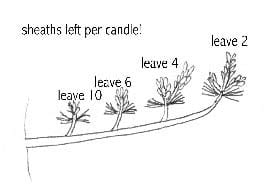The Japanese White Pine family consists of many different sub varieties. This makes a big difference in how you should treat them for training into Bonsai. The most popularly used strains for Bonsai is what the Japanese call Yatsabusa, which means many buds. It has tight compact growth which is particularly easy to create dense foliage pads quickly. Most of the cultivars are grafted onto a Japanese Black Pine rootstock to encourage vigour into them. This is why when pruning and styling Japanese White Pine on their own rootstock you have to be more gentle in its pinching and pruning. You can usually tell if the Bonsai is grafted because the grafted Pines usually have a blue tinge to the foliage rather than the yellow of the non-grafted varieties. In Japan a lot of the Pines are produced in the south around Kyushu where the humidity and temperature is very high, so the growth rate is much faster. Due to these high temperatures the cold and frost does not occur, therefore they grow these Pines in virtually pure grit and just feed heavily. The main problem is when they’re imported into this country, the grit holds a lot of water and intensifies the cold causing root rot, so it is advisable to put them into a warm soil mix such as sifted and graded double red line hard Akadama soil with some of the original Japanese grit. By using some of the existing grit you will get some of the Mycelium into the new soil mix.
N.B: Mycelium is a beneficial fungus that grows around the Pine trees roots, that helps digest nutrients within the soil for the tree to absorb.
Their growth dominance with all the Pines is around the apex of the tree; so it is important to counter balance this by pruning harder in these zones. The biggest disadvantage with creating Pine trees intoBbonsai is they have a tendency to produce only buds and foliage at each node terminal on the trunk. This leads to problems of inverse taper in the trunk where too many branches around the nodes causes trunk swelling around these areas. The best way to counter balance this is by thinning out to a maximum of two appropriate branches per node and, by wiring the main trunk while still young (before bark plating) which will cause adventitious buds along the trunk to form better-staggered branches.
Candle Pinching
The most important aspect of candle pinching is regulating the dominance within the tree, this is why when undertaking any form of pinching you should examine where the tree is putting on most of its growth so you can pinch stronger in these areas. Pinching is done when the needle sheaths are just visible – usually about an Inch long, so the timing is dependent on what the climate dictates. Japanese White Pine can have multiple candles at each growth terminal; therefore you should eradicate the dominant candles leaving only two smaller candles at these areas.

—–Remove the central candle leaving the two smaller opposing candles to encourage finer branch structure. In this diagram this is typical in which a shoot grows with the dominance at the end of the branch, therefore you should regulate this vigour by removing more of the candle around the end of the branch, then by leaving more of the candle as you work into the inner shoots.
The amount of candle you remove is dependent on the dominance of the cultivars, but you must leave at least two to three needle sheaths on the new candle to draw the sap up.

Pruning
The optimum time for pruning this species is between May to the beginning of June when the candles have finished their main burst of growth. This task is done mainly to reduce the vigour around the apex of the tree and to tighten the aesthetic contours of the foliage pads, but remember it is always necessary to cut back to a sap drawer, either by cutting back to a candle or some new growth. On young trees in the early beginnings of training into Bonsai, it can be beneficial to let the primary branches extend, so this draws more energy into the branch, hence causing it to thicken more rapidly, but once the proportional thickness is achieved you should cut back to two opposing buds to create a better twig structured pad.

You should cut back proportionally to where you want the foliage pad to emerge.
Wiring
The best way to get this species to back bud is to apply wire to the tree; this is not just purely done for aesthetic shaping, but to restrict the sap flow to the growth tip. It is very important to remove the wire with wire cutters and not to unwind it off the tree because it is easy to knock off any small new buds. You can wire grafted Japanese White Pine virtually all year round, but it can be easier to wire before buds swell, approximately in January, to prevent knocking them off. With the weaker non-grafted varieties it is important only to wire in the spring when the sap is starting, because they can shed branches if you wire when the growth rate is slowing down. You should prepare the tree for wiring by cutting off the second, third and fourth years needles, leaving only its current needles around the candles. What this does is it makes wiring a much easier task; also it helps light and air into the branch structure helping activate the dormant basal buds at the base of the needle sheaths. On heavily dense Bonsai it can be advisable to needle pluck where you do not wish buds to emerge, for example, around candle junctions. After you have undertaken this task you should place the tree in dappled shade to avoid transpiration through the foliage. Once the tree shows signs of vigour you should place in full sun to ripen the branches to help activate the dormant buds.

Re-potting
The best time to re-pot is when the bud is just swelling, usually around March to April. You should not root prune too hard, because they do not have such a vigorous surge of growth after re-potting compared to most species. It is advisable to prune radially around the root ball leaving as much fine root as possible, using a nice warm soil medium such as 50% sifted and graded double red line Akadama with 50% course grit (such as 3-6mm Kiryu volcanic grit). It is also beneficial to add some of the white fungus growing around the roots to the new soil medium (Mycelium).
Watering
It is important for the reduction of needle length that the tree does not retain too much water in its soil mix, because if it does it will get larger needles, which is not desirable for refinement. This does NOT mean the tree likes to be dry; it just likes regular watering, but not to sit in it. When applying the water you should mist the foliage so the dust is cleaned off the trees breathing pores, because it will hinder full growth. This is the same reason why you should prevent algae build up on the trunk; by cleaning with water and a toothbrush.
Feeding
You should not feed your trees for refinement until after you do the first major pinching, otherwise the tree will put all its intake of energy into the candles causing bigger needles. By feeding after its first pinching it will put its energy into back budding and tighter growth. The best general fertiliser for even consistent growth is the rapeseed cakes, which you place around the edge of the pot and release feed every time you water. One application should last about 4-6 weeks, which you then change for new ones. The last application should be done in the end of August to early September, which will last the tree up to the end of the growing season.
